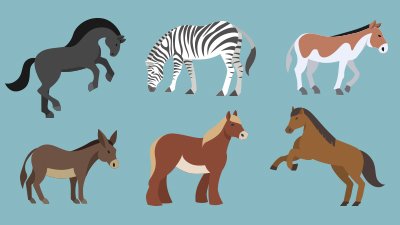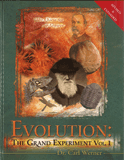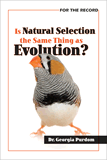Creationists Disbelieve Selection?
Apparently the newest evolutionary icon is the friendly, hefty St. Bernard dog breed—or so hints a University of Manchester press release carried by PhysOrg.com.
News Source
- PhysOrg: “Study Casts Doubt on Creationism”
A team of University of Manchester biologists led by Dr. Chris Klingenberg has concluded that cranial changes in the St. Bernard “can only be explained through evolution and natural selection.” The press release adds that this may “ironically [challenge] the theory of creationism”—ironically because the breed is named after an 11th-century priest. The conclusion, which was published this week in Proceedings of the Royal Society B: Biological Sciences, came after Klingenberg's team examined the skulls of 47 St. Bernards covering a span of 120 years.
“[St. Bernard] features . . . became more exaggerated over time as breeders selected dogs that had the desired physical attributes,” explains Klingenberg. “In effect they have applied selection to move the evolutionary process a considerable way forward, providing a unique opportunity to observe sustained evolutionary change under known selective pressures.”
The “sustained evolutionary change” Klingenberg references is, first, the presence of broader skulls in modern St. Bernards; second, a steeper angle between the nose and forehead in modern St. Bernards; and, third, a more pronounced ridge above the eyes of modern St. Bernards. According to Klingenberg, these three modern features are exactly what the breed standards prefer and would not have originated due to factors of survival. “[W]e can be confident that they have evolved purely through the selective considerations of breeders,” Klingenberg emphasizes.
So, is this evolution in action? It depends on what one accepts as the precise definition of evolution. In the most broad scientific sense, evolution—a word far older than Darwin, by the way—simply refers to fluctuations in a population’s gene frequencies (often specified as expressed gene frequencies) over time. Of course, the word evolution is used so frequently as shorthand for full-scale, molecules-to-man Darwinism that many people are unaware of the more accurate definition.
Using this more specific definition—of fluctuations in gene frequencies—we wholeheartedly agree that the St. Bernard study shows “evolution in action.” But such evolution in action bears only a fantasized resemblance to the molecules-to-man narrative Darwin (and others) popularized. The fluctuations in the skull shapes of St. Bernards have occurred due to artificial (breeder, in this case) selection of the genes already present in the St. Bernard genome. No matter what the fervor of the dog breeders, they can only select genotypes (or phenotypes, more specifically) that already exist. Studies of information theory invariably reinforce the principle that information originates only from information, not from randomness; thus, the “evolution” observed in St. Bernard skulls in no way corroborates the eons of information-gaining “evolution” some scientists invoke to explain our existence.
So, what about selection, both natural and artificial—what do creationists think? First, selection/adaptation in no way contradicts the explanation for the origin of life presented by Genesis; on the contrary, it is understandable that an all-knowing God would invent a mechanism of adaptation for His creatures. Second, selection/adaptation is observed in the present, unlike molecules-to-man evolution, which is a framework about the unrepeatable past designed to explain evidence we uncover in the present. Third, the principles of natural selection were outlined by creationists, such as English chemist and zoologist Edward Blyth, before being later adopted and recast by the likes of Darwin.
Klingenberg's own words suggest the root problem is simple ignorance.
Without exception, evolutionists’ showpieces of “evolution in action” are really just (at best) examples of natural or artificial selection manipulating existing genetic information and resulting in phenotypic changes over multiple generations. Why, then, are these examples widely trumpeted in the media as countering creation theory? Klingenberg's own words suggest the root problem is simple ignorance:
Creationism is the belief that all living organisms were created according to Genesis in six days by ‘intelligent design’ and rejects the scientific theories of natural selection and evolution.
But this research once again demonstrates how selection—whether natural or, in this case, artificially influenced by man—is the fundamental driving force behind the evolution of life on the planet.
Klingenberg’s blatant error in stating that “creationism . . . rejects . . . natural selection” in the first paragraph can’t help but cause us to doubt his conclusions in the second paragraph!
Further Reading
- 2.2 Natural Selection
- Get Answers: Information Theory, Natural Selection, Speciation
For More Information: Get Answers
Remember, if you see a news story that might merit some attention, let us know about it! (Note: if the story originates from the Associated Press, FOX News, MSNBC, the New York Times, or another major national media outlet, we will most likely have already heard about it.) And thanks to all of our readers who have submitted great news tips to us. If you didn’t catch all the latest News to Know, why not take a look to see what you’ve missed?
(Please note that links will take you directly to the source. Answers in Genesis is not responsible for content on the websites to which we refer. For more information, please see our Privacy Policy.)
Recommended Resources

Answers in Genesis is an apologetics ministry, dedicated to helping Christians defend their faith and proclaim the good news of Jesus Christ.
- Customer Service 800.778.3390
- © 2024 Answers in Genesis








